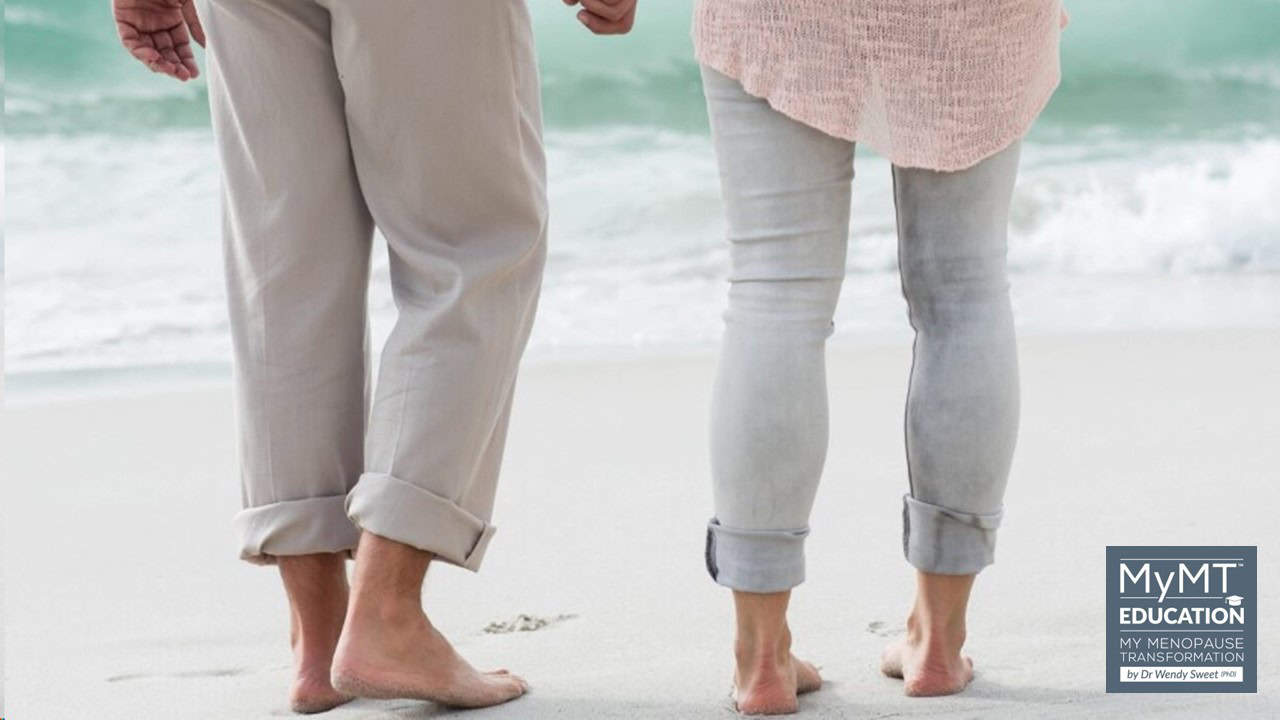Whether it’s on grass, or concrete, a forest track or the beach, then explaining to your midlife female clients to kick off their shoes and ‘ground’ themselves with the earth’s surface for a minimum of 15 minutes, is an important part of your anti-inflammatory menopause symptom management coaching.
This practice is known as ‘grounding’ or ‘earthing’ and at a time when I was struggling with increased hot flushes, inflammation and high blood pressure, and purchasing so many supplements, this was never mentioned as an important menopause-symptom strategy.
Relatively new multi-disciplinary research has revealed that electrically conductive contact of the human body with the surface of the Earth (grounding or earthing) produces intriguing effects on physiology and health. (Menigoz et al, 2020; Sinatra et al, 2023)
These effects range from reducing inflammation, improving immune responses, enhancing wound healing, and the prevention and treatment of chronic inflammatory and autoimmune diseases, including bone and cardiac health – two significant health conditions that are known to affect women as they move into post-menopause.
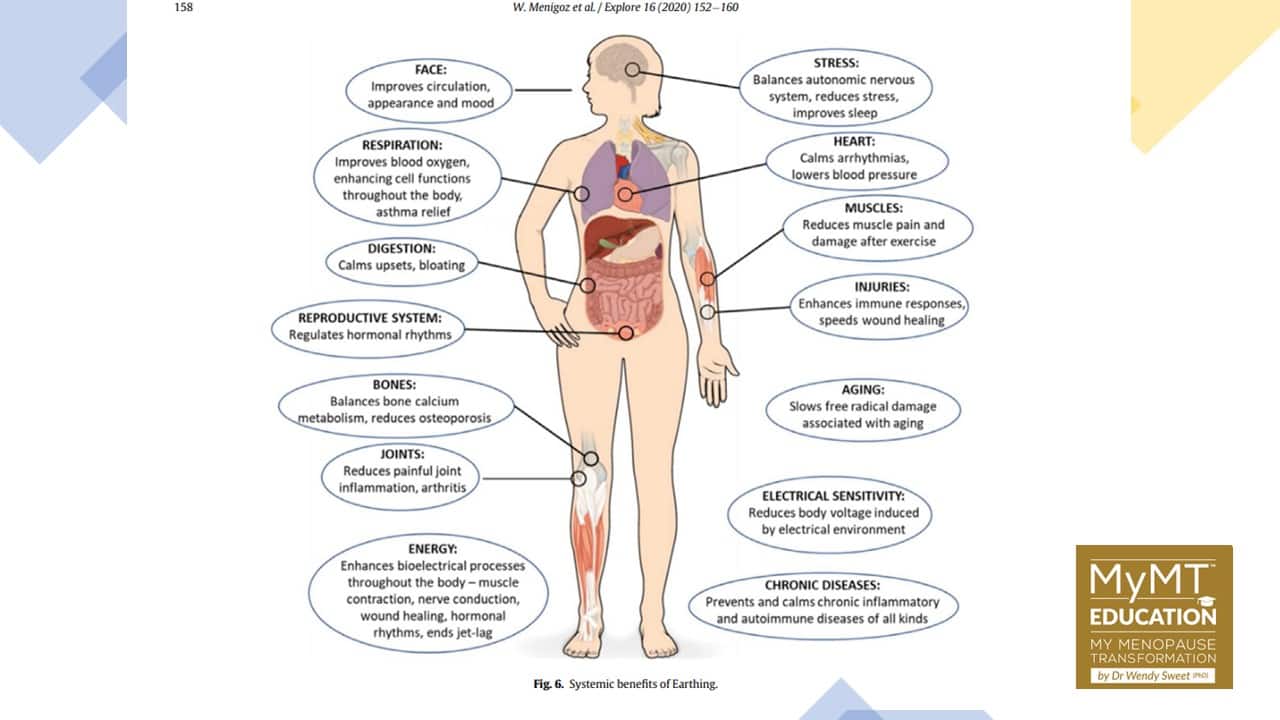
Health information is rapidly changing as newer research emerges about approaches to inflammatory states in the body. As many of you already know, through my own research, I’ve positioned the peri-menopause to post-menopause transition in women’s health and ageing studies.
As such, paying attention to research on inflammation and how to regulate it matters. Ageing itself is known to be an inflammatory event in a women’s life-cycle and menopause is the transition to the next stage of a woman’s life – her ageing years.
It’s an important life-stage for women to reflect on the factors that contribute to inflammatory changes in the body – past and present – especially if they want to take back control of their hot flushes or Vasomotor Symptoms (VMS).
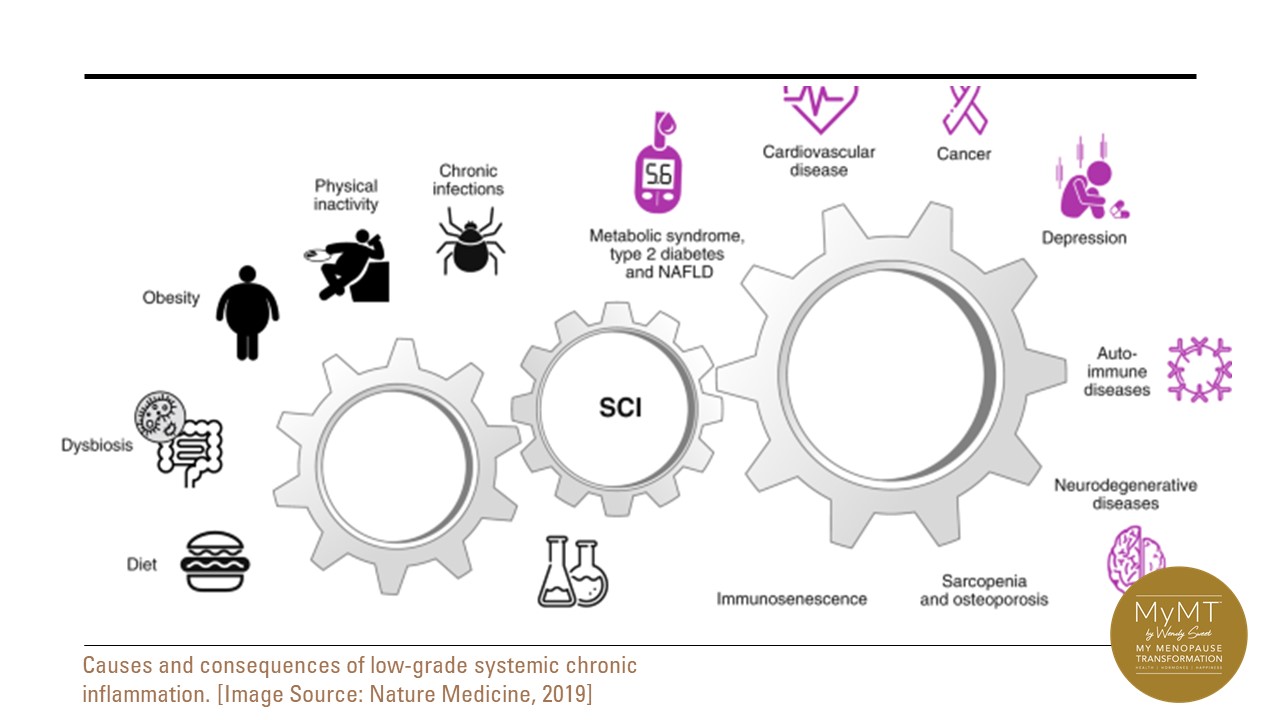
Vasomotor symptoms (VMS), commonly called hot flashes or flushes (HFs) and night sweats, are the menopausal symptoms for which women seek treatment during menopause most often.
VMS are a form of temperature dysfunction that occurs due to changes in gonadal hormones. Hot flashes are reported by up to 85% of menopausal women (Santoro et al., 2015)
Normally, core body temperature remains within a specific range, oscillating with daily circadian rhythms. Physiological processes that conserve and dissipate heat are responsible for maintaining core body temperature, therefore, tight regulation is important for maintenance of optimal internal organ function.
Menopause hormonal shifts can disrupt this tightly controlled temperature circuit resulting in exaggerated heat-loss responses. This presents as vasomotor symptoms (VMS) or hot flushes/ flashes.
Dysfunction in the regulation of temperature mechanisms during the menopause transition leads to inflammatory changes around the body. This is why the peri-menopause transition to menopause, is known as an inflammatory phase of a women’s life-cycle (McCarthy & Raval, 2020).
When inflammatory changes are present in the body, cortisol levels can remain elevated. Cortisol is a well-known marker of inflammation in the body. Elevated cortisol levels may then lead to HPA-Thyroid Axis dysfunction.
The connection between the pituitary, thyroid and stress hormones during the menopause transition can cause homeostatic imbalances that impact temperature regulation. When this happens to your midlife clients, their blood pressure might increase, as does inflammatory changes in joints and sleep disruption. Daytime hot flushes and/or night sweats might increase too.
However, with the knowledge of temperature regulation disruption and how the body naturally regulates temperature, this opens up the curiosity towards the powerful lifestyle solutions that you can help your clients to put into action to turn down the heat and stop the sweat.
One of these strategies is simply called ‘earthing’ or ‘grounding’.
Every woman who joins me on the 12 week MyMT programmes, will hear me talk about this in their modules, especially if they feel anxious, aren’t sleeping, are experiencing hot flushes or have sore joints and muscles.
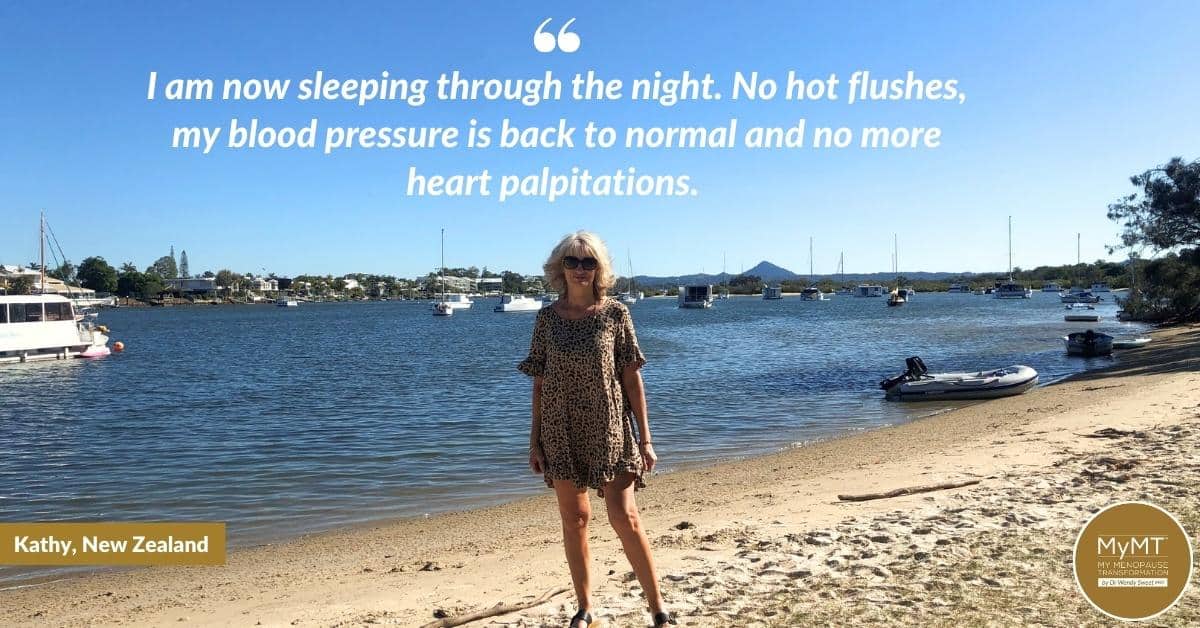
Grounding or earthing refers to direct skin contact with the surface of the Earth, such as with bare feet or hands, or these days, there are various grounding systems you can purchase as well.
Earthing works by connecting the skin to the surface of the earth. This contact then allows Earth’s electrons to spread over the skin surface and into the body.
Skin is the largest organ in the body. If skin was peeled off, apparently we would lose about 12 kg (27lb) just like that! (Carver, 2017). The skin on the soles of the feet is eight times thicker than the skin on the eyelids, and it works as a barrier to keep our immune system strong.
Skin is also on a circadian cycle and therefore, is linked to temperature regulation in the body, especially through skin temperature. [Lyons et al, 2019].
The core body temperature therefore, has predictable fluctuations with higher temperatures in the daylight hours than during the night hours. For women in their menopause transition, these higher daylight hours body temperatures can be problematic and uncomfortable. I know this only too well myself.
Oestrogens are well-known as potent neuro-modulators (nerve-regulators) of numerous nerve pathways so, changing oestrogen levels during menopause impact temperature balance. This process is known as temperature homeostasis.
When our sleep is affected in menopause and because our blood vessels, sweat glands and nerves lose the role of oestrogen, it’s no surprise that we end up with exaggerated heat-loss responses that present throughout the day and night as hot flushes and night sweats. [Deecher, 2007]
This is where grounding, or ‘earthing’ comes into the science of lifestyle medicine. Pioneered by the late American Cardiologist, Dr Stephen Sinatra, one of the most important investigations that he undertook, was to explore the effects of earthing on inflammatory changes in blood vessels and blood viscosity (thickness). (Sinatra et al, 2023).
As he mentions, ‘thick, clumped blood is the hallmark of not only diabetes but cardiovascular disease as well. Obviously, the lower viscosity or the thinner your blood is, the less vulnerable it is to clotting or thrombosis.’ (Sinatra et al, 2023, p.13).
This is where walking barefoot for around 30 minutes daily offers an astonishing reduction in blood viscosity and body temperature.
Whether on grass, or concrete or sand, barefoot walking helps to re-activate our ancient cooling mechanism and reduce the build-up of inflammation in cells and tissues. It’s the natural anti-inflammatory therapy that is free, easy to implement and improves quality of life for women, who feel ‘hot’ all the time.
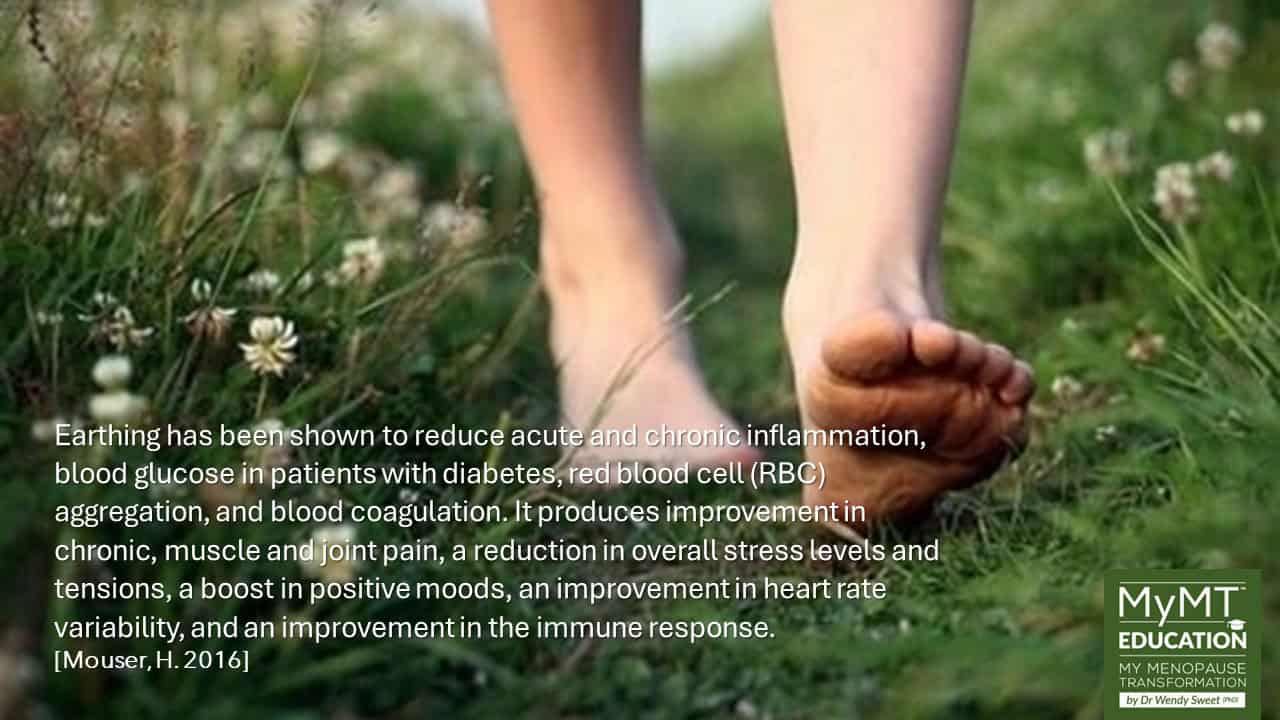
A number of clinical studies indicate that ground the body generates beneficial and significant physiological changes. These benefits range from improving vascular blood flow to reducing Type 2 diabetes, to improving inflammatory markers.
Modern lifestyles, especially wearing synthetic shoes, can prevent the flow of electrons throughout the body, thus restoring the body’s own defence mechanisms. As Dr Sinatra mentions, ‘when energy supply is restored to the body through grounding, humans have the potential to thrive.
Drawing your attention to these practical, lifestyle medicine solutions, is the purpose of the courses that I have for you in MyMT™ Education. Your purpose is to bring these strategies to the attention of your midlife, female clients as they move through one of the most significant inflammatory events in their life – menopause. I hope you can join me sometime on the CPD-Approved Health Practitioner Course.
Dr Wendy Sweet (PhD)/ MyMT™ Founder and Member: Australasian Society of Lifestyle Medicine.
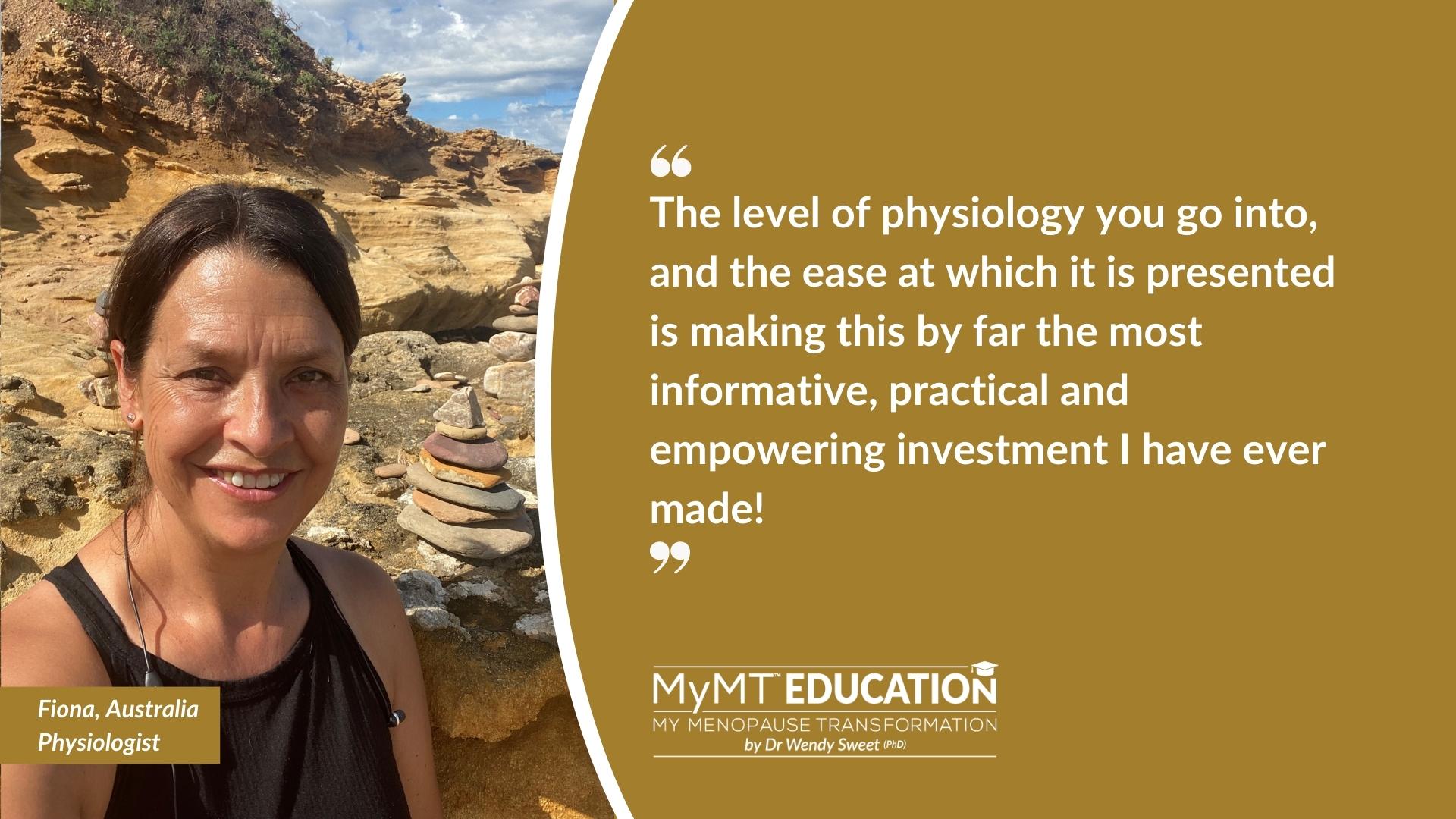
References:
Chevalier, G., Sinatra, S. T., Oschman, J. L., & Delany, R. M. (2013). Earthing (grounding) the human body reduces blood viscosity – a major factor in cardiovascular disease. Journal of alternative and complementary medicine (New York, N.Y.), 19(2), 102–110. https://doi.org/10.1089/acm.2011.0820
Chevalier, G., Sinatra, S. T., Oschman, J. L., Sokal, K., & Sokal, P. (2012). Earthing: health implications of reconnecting the human body to the Earth’s surface electrons. Journal of environmental and public health, 2012, 291541. https://doi.org/10.1155/2012/291541
Deecher DC, Dorries K. Understanding the pathophysiology of vasomotor symptoms (hot flushes and night sweats) that occur in perimenopause, menopause, and postmenopause life stages. Arch Womens Ment Health. 2007;10(6):247-257. doi:10.1007/s00737-007-0209-5
Lyons AB, Moy L, Moy R, Tung R. Circadian Rhythm and the Skin: A Review of the Literature. J Clin Aesthet Dermatol. 2019 Sep;12(9):42-45. Epub 2019 Sep 1.
Menigoz W, Latz TT, Ely RA, Kamei C, Melvin G, Sinatra D. Integrative and lifestyle medicine strategies should include Earthing (grounding): Review of research evidence and clinical observations. Explore (NY). 2020 May-Jun;16(3):152-160. doi: 10.1016/j.explore.2019.10.005.
Santoro N, Epperson CN, Mathews SB. Menopausal Symptoms and Their Management. Endocrinol Metab Clin North Am. 2015 Sep;44(3):497-515. doi: 10.1016/j.ecl.2015.05.001.
Sinatra ST, Sinatra DS, Sinatra SW, Chevalier G. Grounding – The universal anti-inflammatory remedy. Biomed J. 2023 Feb;46(1):11-16. doi: 10.1016/j.bj.2022.12.002.
